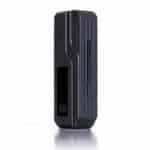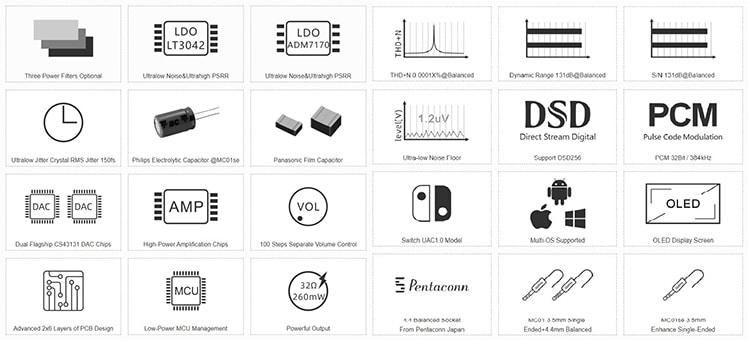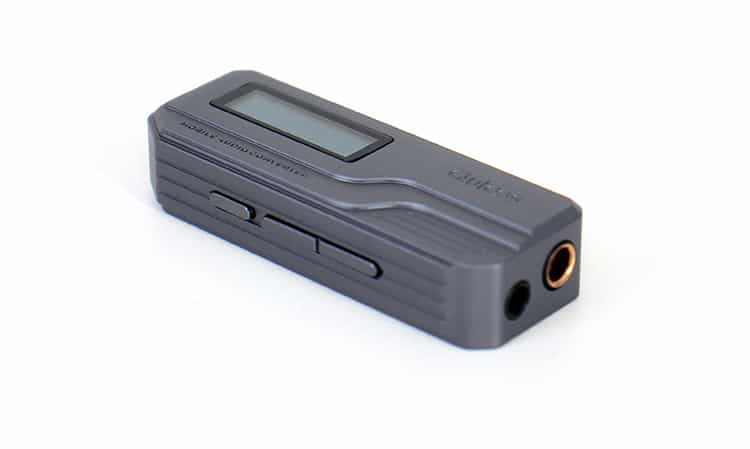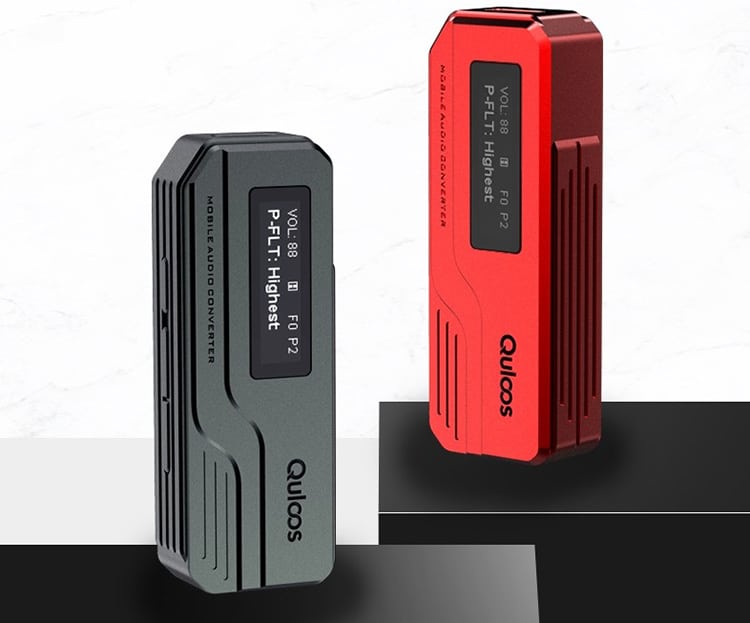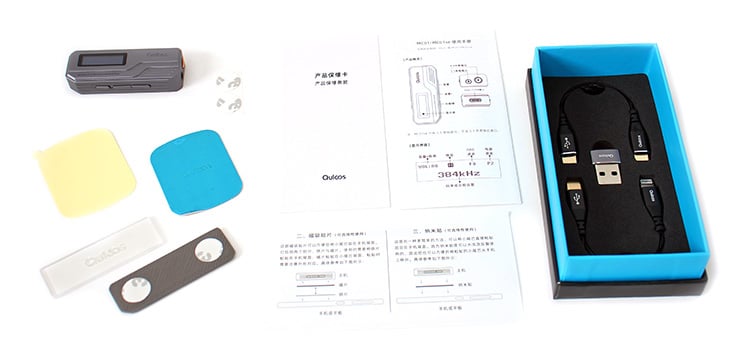In this feature, we review the Quloos QLS MC01, which is a dongle-type balanced portable DSD256 DAC and 260mW capable headphone amplifier. It is priced at $249.99.
Disclaimer: This sample was sent to us in exchange for our honest opinion. Headfonics is an independent website with no affiliate links or status. We thank Quloos and Shenzhen Audio for their support.
To read more about dongle products we have previously featured on Headfonics, click here.
Note, that this article follows our latest scoring guidelines which you can read here.
Quloos has entered the dongle DAC rush with a model that seems to be designed with a high level of emphasis placed on appearance, similar to the LP W2. The QLS MC01 shows off many body countors and lines which accentuate this dongle DAC’s visual appeal.
On the surface, the QLS MC01 has many design characteristics and details, probably more so than other models out there. Not only is it rather elaborate in design but it also comes in two color schemes, charcoal, and red.
We received one with a charcoal grey finish but the red model looks just as interesting or probably even more so since most gear nowadays seems to be simply painted black as instructed by the Rolling Stones. So the idea of an alternative color seems somewhat attractive to me at this point.
There are also two versions available of the MC01 with different output configurations. There’s a dual 4.4mm alongside a 3.5mm equipped version and a single 3.5mm version which is the MC01se. We got the one equipped with a balanced out, the MC01.
Tech Highlights
We could take part of the day talking about how intricate the Quloos QLS MC01 looks on the outside but what matters is what’s under that hood. Let’s start with the dual Cirrus Logic CS43131 which is an often sourced chip nowadays. The QLS MC01 in particular uses a 2+2 configuration, a dual DAC section, and a dual Amp all QFC setup.
Quloos doesn’t specify the amplification medium but they claim the MC01 has similarities with their QA361 so I’m assuming they used the same dual OPA6122 chips which also come in QFN packages and would theoretically be an obvious good call.
It seems they use one for the SE MC01se and doubled up on the balanced output MC01 model according to the specs sheet, contrary to the QA361 which uses six.
A 150fs Femtosecond crystal oscillator keeps the symphony in check. Particular attention seems to be placed on keeping a high-quality profile since Quloos mentions the use of Philips electrolytic and Panasonic film capacitors throughout.
To feed all that array of components the QLS MC01 employs a selectable triple LDO filter setup behind two low noise LDO chips, an LT3042 and an ADM7170 that claim on specs high PSRR rejection ratios along with the MCU low power management option implementation.
Digital formats
It seems the only modern digital format that’s not compatible with the Quloos QLS MC01 is MQA because the other modern, or shall we say more common formats play well on this dongle DAC.
PCM can go 16 or 24-bit audio at up to 384kHz plus DSD64, DSD128, or DSD256 native or DoP on any of the confirmed compatible devices. The QLS MC01 works on Windows, macOS, Android, iOS, and iPad OS plus I confirmed it also works on Chromebook OS.
The USB interface runs on 2.0 natively but the dongle can be dropped down to operate on UAC 1.0 which is sometimes referred to as gaming mode if you happen to run into issues on UAC2.0 with some game consoles.
Design
Branching off the tech highlights, all the Quloos QLS MC01 circuitry sits on two 6-layer PCBs. I’ve seen other dongle DAC makers employ a similar technique. This facilitates engineers to keep certain sections of the circuitry isolated from each other.
The shell itself seems to be made of high-quality aluminum, run through a CNC machine, and anodized afterward with one of the two available colors. The shell seems to be assembled from two separate pieces held together by two set screws which can be seen on the backside of the shell.
There are several characteristics here worth mentioning. First of all, there’s not a sharp edge on the Quloos QLS MC01 anywhere. Each corner is shaped at a 45-degree angle which also seems to be polished off some.
The shell shows channeling and swirls embedded within the shell along with a 1” OLED display, a few buttons which consist of two volume buttons, and a mode switch plus all the connectivity is what’s visible.
I/O
If you get the MC01se then you’ll only get a unit with a 3.5mm single-end connection. The QLS MC01 has two, the 3.5mm and a balanced 4.4mm connection. Both headphone connections are at one end of the dongle and in a side-by-side traditional manner.
One cool feature this particular dongle has is the 100-step volume control to manage those connections. Even better, this volume works independently from the volume source which translates into a very fine volume adjustment capability.
The other end of the dongle shell has a single USB-C female connection which can be switched to operate at a USB UAC 1.0. In stock form, the QLS MC01 works on a backward-compatible USB 2.0 interface.
The QLS MC01 is compatible with almost anything you could come up with. It works on practically everything that has a USB connection. There’s multi-OS support including IOS and MAC, Windows, Android, and Chrome OS compatibility. I verified three of the five mentioned myself that work the QLS MC01 well.
OLED Screen
The OLED screen shows off some useful information like volume level and bitrate along with an indicator for high and low gain positions. There’s also a DAC filter indicator and a power filter indicator.
All these features are accessible by pressing the mode button once. you scroll through all these features each time you press the mode button then the up or down volume button changes the individual feature’s options.
The power filter feature includes 3 sets categorized as normal, high, and highest. These have nothing to do with power output but rather employ more rigorous power filtration but in return consume more power the higher the level is set.
Besides that, there are also two gain levels, an OLED screen brightness adjustment and time out, a balance control, and a DAC filter selector. You could select between five which are LL fast, LL slow, fast, slow and Nos.
Packaging & Accessories
I found some of the items included with the Quloos QLS MC01 to be unique. First, off they supply the user with a good level of connectivity and throw in a Lightning connector terminated cable along with a dual USB-C cable. I’m not an iPhone user but I’m glad Quloos didn’t leave them out to fend for themselves.
All the literature that came with my unit was written in Chinese but you could download an English version along with a USB driver from their website. I couldn’t find any software for this particular dongle DAC anywhere so firmware updates are up in the air right now.
This dongle comes with some rather odd accessories. For example a gel pad around two inches long that I have no idea what it’s for along with some round stickers, a Quloos metal plaque, and a sticker that is blank on both sides. Perhaps for protective stacking? Not a word is mentioned on what these items were included for anywhere.
Sound Impressions
Summary
I kept the Quloos QLS MC01 on the NOS filter most of the time and it seems the usable five filters are so similar that when I switched back and forth in a blind test I would probably think they were all the same.
The main characteristics sonically obtained on the QLS MC01 could be described as neutral, a natural timbre, and a well-extended frequency response both ways. This dongle seems to portray a hygienic quality that is free from harshness but is almost undramatic and somewhat aseptic.
It seems the highs in particular have been prostrated so they never touch ardent or intense levels. The midrange is flat as a flap jack with a medium amount of body which seems supple. The bass is well represented and is not bloated nor is it anemic and there seems to be a good amount of presence and energy in the bass region.
Details are prominent and more so on this dongle than others I’ve heard particularly those at half the cost dollarwise. There’s not a heavy level of micro detail but background nuances seem forward and more present compared to similar dongles. I guess that could be this dongle’s niche in sound character.
Staging & Dynamics
If you consider the overall dynamics and the listed specs they seem to be softened up some. The Quloos QLS MC01 seems to cater to buyers who are looking for a relaxed signature and well-defined music behind a black background.
The QLS MC01 caters to listeners who want to relax rather than be bombarded with fidelity, forwardness, and, or intensity. I could describe the overall character as almost effortless but very resolving.
It seems a side product of the soft nature stems from the wide stage with good micro and macro placement which can be emitted with the right headphones. You could easily distinguish a small nuance and within the same area detect a larger note.
Depth is decent except for perhaps a small underfill in imaging on both sides of the phantom center which makes recording at times feel three-dimensional or three-sided.
Click on page 2 below for pairings and our select comparisons.


